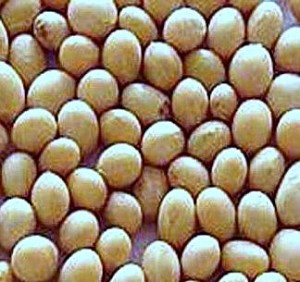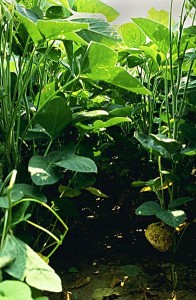 Soybean or Soya bean (Glycine max), one of the most important legumes describe as wonder crop of the 20th century and a native to East Asia. The plant is classed as an oilseed rather than a pulse. It is an annual plant that has been used in China for 5,000 years to primarily add nitrogen into the soil as part of crop rotation. The plant is sometimes referred to as greater bean.
Soybean or Soya bean (Glycine max), one of the most important legumes describe as wonder crop of the 20th century and a native to East Asia. The plant is classed as an oilseed rather than a pulse. It is an annual plant that has been used in China for 5,000 years to primarily add nitrogen into the soil as part of crop rotation. The plant is sometimes referred to as greater bean.
Traditional non-fermented food uses of soybeans include soymilk, tofu and tofu skin or yuba. Fermented foods include shoyu or soy sauce, miso, natto, tempeh, Ketjap among others. Soybeans are an important global crop, providing oil and protein. The beans contain significant amounts of phytic acid, alpha-Linolenic acid, and the isoflavones genistein and daidzein. The whole bean can be used in stews and soups and the green immature soybeans are consume in Asia as a vegetable.
Production of Soybean
Varieties:
Many soybean varieties are available. A collection of over 10,000 accessions of soybean seeds is maintained by the USDA. This USDA collection represents the diversity of soybean germplasm including seeds of every color and description including red, green, black, brown, speckled, streaked, large, and small.
Most of soybean varieties grown commercially today are yellow-seeded field varieties used for animal feed and oil production (for food processing and industrial uses). Other varieties can be obtained for special uses: forage and hay (with an abundance of stems and leaves) and human food (large-seeded, various colored varieties).
Uses of Soybean
Soybean as Feed
- high protein content (40-45%) in terms of amino acid composition
- adequate amount of vitamins & minerals
- as fodder & forage
Raw Materials for Industry
- used as solvent and in making dyes, synthetic resins, lacquers, glues, paper coating
- soybean oil for foaming, dispersing and wetting agents (lecithin)
Soybean as Food
- ingredients in traditional meal dishes
- fermented products such as soy sauce (toyo), soy cheese, soy paste, etc.
- soy bean milk
Soil Requirements
- deep, well drain fertile clay loam or sandy loam
- with soil pH 5.8-6.5
Climatic Requirements
- less rainfall during wet season and only a short dry season
- temperatures ranges from 10ºC – 40ºC
Land Preparation
- Soil must have favorable moisture
- 2-3 times plowing for carabao drawn implements
- 2 plowing is enough using 4WT
Soybean is a hardy plant and well adapted to a variety of soils and soil conditions. Producing the best quality crop and maximum yields will require top quality soil. Thus, soil is one of the first things to consider when planting a crop. A healthy, fertile, workable soil will actually provide seedlings and growing plants with protection from adverse weather including cold, frost, drought, excess water, and protection from pests and diseases.
Ideal soil for optimum soybean production is a loose, well-drained loam. Many fields have tight, high clay soil that becomes waterlogged when it rains. When the soil dries out, a hard crust surface may form which is a barrier to emerging seedlings. These high clay soils are low in humus and may have imbalance in mineral nutrients. Also, these soils may have few beneficial soil organisms (bacteria, fungi, algae, protozoa, earthworms and others). High clay soils may be amended with peat moss, sphagnum, organic mulch to increase the humus content. Sand may be added to loosen and aerate the soil and allow better drainage.
The advantages of loose, well-aerated soil include (1) movement of air to roots and nitrogen-fixing root nodules, (2) increased water-holding capacity with adequate drainage, (3) reduced erosion, (4) reduced weed populations, (5) maintenance of steady and balanced nutrients to roots and balance pH, and (6) increased potential to protect roots from harmful nematodes, insects pests, and pathogens.
Planting & Fertilization
- Furrow distance 40-50 cm apart
- seed are drilled at the rate of 25-30 per linear meter or 50-60 kg per ha
- plant density 300,000-400,000 plants/ha
- 2 bags 14-14-14(basal)
Typically, beans planted during early May have the best yield potential. However, yield depends on several other factors, too. Growing conditions at planting time will influence the success of seed germination and seedling vigor. Just because the calendar says it’s time to plant doesn’t guarantee that it’s the optimum time to plant soybeans. Soybeans need a minimum soil temperature of 55 to 60o Fahrenheit to germinate. Germination rates increase at warmer temperatures. A seed that’s in the soil but cannot rapidly germinate and emerge above the soil surface will have a higher chance of exposure to diseases and damping off.
The ideal seedbed for soybeans should provide moisture and the appropriate temperature warmth for rapid germination and seedling emergence. Soil should remain friable without crusting over when dry. Germination of weed seeds should be delayed or prevented.
Soil moisture (about 50% of the soybean weight) must be sufficient to allow uniform and steady germination rates. If soybeans germinate and grow rapidly, weeds can be shaded out. To reduce or discourage weeds, allow the space between the planted rows to remain covered by residue. Another approach is to prepare the seedbed early, let the weeds germinate, then work the seedbed to kill sprouted weeds before planting.
If soybeans have not been grown in a particular location for three to five years, it is best to inoculate the seed with the proper strain of nitrogen-fixing bacteria (Rhizobium). Some strains are more effective nitrogen fixers than others. Both seed and soil inoculum are available.
Germination and Emergence
Germination is time after the seed is planted in the soil and before the young seedling emerges above the soil surface. After being planted in the soil, the seed absorbs moisture (called imbibition), changing from less than 13% moisture to about 50% in several hours. After one or two days the first root (called the radical) emerges through the seed coat and begins growing downward to establish the root system.
About five to ten days after planting, the new seedling arches through the soil surface (this is called emergence). The hypocotyl ‘hook’ (the emerging portion just below the cotyledons) begins to lengthen pulling the remainder of the seed upward, and the oval seed leaves (called cotyledons) open up. The cotyledons provide the seedling with a temporary source of food (plant useable nutrients originally stored as the seed was formed). The cotyledons quickly turn green and begin making additional food by photosynthesis. Shortly after the first set of true photosynthetic leaves is formed, the cotyledons drop off.
Seed germination and emergence is a critical period in the life of a soybean because poor emergence due to low temperatures, a soil crust, or seed planted too deeply allows seedling pests or diseases to drastically reduce yield.
Cultivation, Weeding & Side dressing
- Off-barring 15-21 DAP
- Apply remaining 2 bags triple 14, 30-35 DAP
- Hilling-up 30-35 DAP

Optimum Planting Depth, Row Width, and Plant Density
Planting Depth
- Seeds should be planted deep enough to meet the moisture and temperature requirements for germination. Planting depth may be determined by variety, and some varieties can emerge from greater depths than others (usually the larger seeded varieties). Typical planting depths are 1-1.5 inches, but if soil is low in moisture or sandy, plant 2 inches deep. In cool, moist soil, seed can be planted 1 inch deep. Seldom should soybeans be planted deeper than 2.5 inches.
Plant Density/Population
- Plant population varies depending on row spacing and environmental factors. A final plant population may range from 70,000 to 180,000. Typically, 150,000 is a good target for wide rows and 175,000 for narrow rows. Planting an excessive population may result in increased lodging, but an inadequate or uninformed stand may lead to higher weed populations. At lower populations, plants branch more and lodge less, while at high populations the opposite is true. Pods form higher on the plant in high populations. Weeds are more of a problem in low populations. Populations should be adjusted to reduce lodging and keep pods high on the plant. Populations can be increased when growing determinate, semi-dwarf and non-branching varieties. Additionally, the local soil type, environment, and seed quality can influence plant density.
Row Width
- An important goal is stand uniformity. In general, if weeds are controlled, soybeans will yield more in narrow rows than in 30 inch rows. Benefits from narrowing the row width will depend on location, soil conditions, weather conditions, planting date, and variety. In northern and central regions of the U.S., soybeans grown in narrow rows yield more than those grown in corn-width rows. In southern areas, there is a similar trend toward narrower rows and higher yield if good weed control is achieved. The ‘rule of thumb’ is that the soybean canopy should completely close (cover and shade the space between rows) by flowering time. The faster the soybean canopy closes, the fewer the number of weeds will grow. In narrow rows, weeds can not be cultivated easily.
Irrigation Schedules
- First Irrigation – 2-3 days before last harrowing
- Second Irrigation – 15 DAP or 2-3 days before fertilizer application & off-barring
- Third Irrigation – 30 DAP 0r 2-3 before hilling-up
- Fourth Irrigation – 50-55 DAP
- Fifth Irrigation – 65-70 DAP
- Sixth – Optional, if plants pods are still green
Common Insect Pest
- Beanfly Beetle
- Adult pod borer
Common Soybean Diseases
- Seedling Blight/Damping-off
- Root Rot
- Bacterial Blight
- Asian soybean Rust
- Soybean Mosaic Virus
- Downey Mildew
- Stem Canker
- Brown Spot
Prevention & Control
- Use resistant varieties
- Practice crop rotation
- Practice IPM (bio-control)
- Chemical control
Harvesting/Drying
- indicated by the yellowing of the pods and falling leaves
- moisture content must be 16-18 %
- drying systems used for corn & grain sorghum are adaptable to soybeans
- Split soybean are susceptible to Molds and fungi invasions
Storing
- Store uniformly dried soybeans at 14 % MC if stored less than 6 months and 11 % for longer storage
- Practice Sanitation, Aeration and Monitoring (SAM)
Source: eap.mcgill.ca; Photos: Wikipedia.org